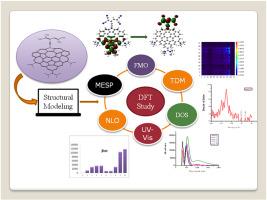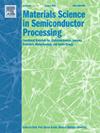利用菲啰咔唑建立类似石墨烯结构的模型,以定制二阶非线性光学特性
IF 4.2
3区 工程技术
Q2 ENGINEERING, ELECTRICAL & ELECTRONIC
引用次数: 0
摘要
较低的带隙和出色的分子内电荷转移对开发分子的强非线性光学(NLO)特性起着关键作用。在目前的研究中,我们设计了一系列类似石墨烯的分子,并战略性地将其有机片段与菲咔唑和 1,3-四氰丁二烯(TCBD)片段相邻。用 CAM-B3LYPP/6-311+G(d,p) 密度泛函理论(DFT)方法评估了所设计衍生物的非线性光学特性。对非线性光学特性的分析包括静态极化率(α0)、一阶超极化率(βtot)和带隙。计算结果显示,所设计的分子具有更好的 NLO 响应,分子 10 的 βtot 最高(117871 au)。在相同的理论水平上,还进行了基于时变密度泛函理论的吸收光谱计算。计算结果发现,随着设计衍生物带隙的减小,出现了红移趋势。此外,为了证实我们的发现,我们还在同一理论水平上计算了状态密度 (DOS)、分子静电位 (MESP) 和过渡密度矩阵 (TDM)。因此,所设计的衍生物揭示了高效 TCBD 基团与类似石墨烯的分子体系和供体基团可用于设计新的 NLO 应用分子图案。本文章由计算机程序翻译,如有差异,请以英文原文为准。

Modeling of graphene like structure by utilizing phenanthrocarbazole for tailoring the second-order nonlinear optical properties
Lower band gap with excellent intramolecular charge transfer plays a pivotal role towards developing the strong nonlinear optical (NLO) properties in a molecule. In the current investigation, we have designed a series of graphene like molecules with promising organic fragments that we have strategically adjoin the phenanthrocarbazole and tetracyanobuta-1,3-dienes (TCBD) fragment. Density functional theory (DFT) approach with CAM-B3LYPP/6-311+G(d,p) were performed to evaluate the nonlinear optical properties of designed derivative. The NLO characteristics were analysed the static polarizability (α0), first order hyperpolarizabilities (βtot) and band gap. The calculated results revealed that the designed molecules have better NLO response and highest βtot were observed for molecule 10 (117871 au). Time dependent density functional based theories at the same level of theory were also performed to calculate the absorption spectra. The calculated results observed that there was a red shift trend with reduced band gap of designed derivative. Further, to substantiate our finding, we have also calculated density of states (DOS), molecular electrostatic potential (MESP) and transition density matrix (TDM) at the same level of theory. As a consequence the designed derivative shed light that the efficient TCBD group with graphene like molecular system and donor group can be utilized to design new molecular motif for NLO applications.
求助全文
通过发布文献求助,成功后即可免费获取论文全文。
去求助
来源期刊

Materials Science in Semiconductor Processing
工程技术-材料科学:综合
CiteScore
8.00
自引率
4.90%
发文量
780
审稿时长
42 days
期刊介绍:
Materials Science in Semiconductor Processing provides a unique forum for the discussion of novel processing, applications and theoretical studies of functional materials and devices for (opto)electronics, sensors, detectors, biotechnology and green energy.
Each issue will aim to provide a snapshot of current insights, new achievements, breakthroughs and future trends in such diverse fields as microelectronics, energy conversion and storage, communications, biotechnology, (photo)catalysis, nano- and thin-film technology, hybrid and composite materials, chemical processing, vapor-phase deposition, device fabrication, and modelling, which are the backbone of advanced semiconductor processing and applications.
Coverage will include: advanced lithography for submicron devices; etching and related topics; ion implantation; damage evolution and related issues; plasma and thermal CVD; rapid thermal processing; advanced metallization and interconnect schemes; thin dielectric layers, oxidation; sol-gel processing; chemical bath and (electro)chemical deposition; compound semiconductor processing; new non-oxide materials and their applications; (macro)molecular and hybrid materials; molecular dynamics, ab-initio methods, Monte Carlo, etc.; new materials and processes for discrete and integrated circuits; magnetic materials and spintronics; heterostructures and quantum devices; engineering of the electrical and optical properties of semiconductors; crystal growth mechanisms; reliability, defect density, intrinsic impurities and defects.
 求助内容:
求助内容: 应助结果提醒方式:
应助结果提醒方式:


